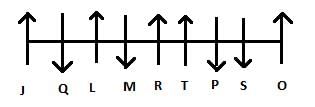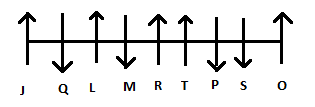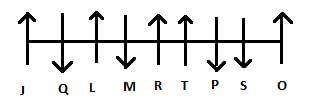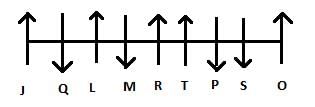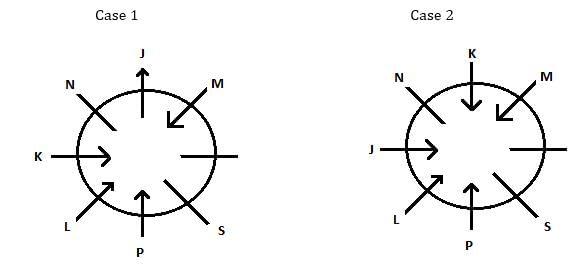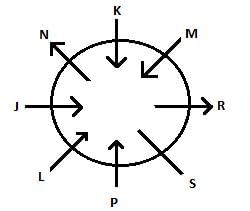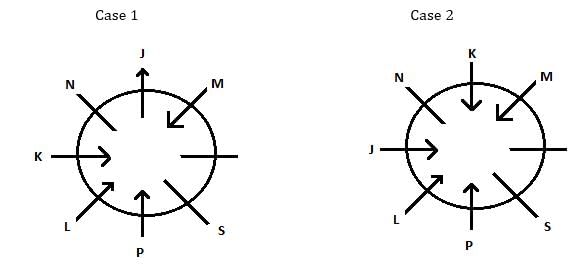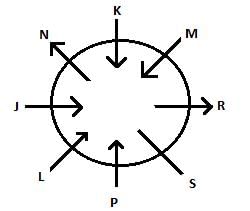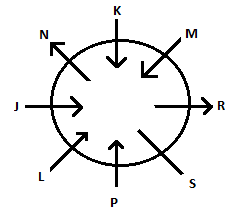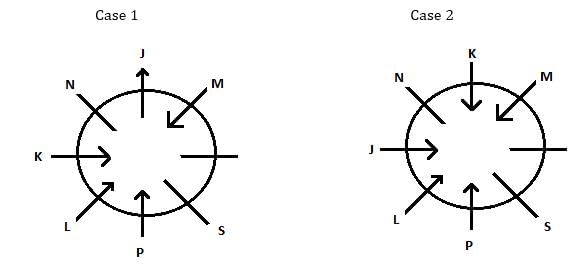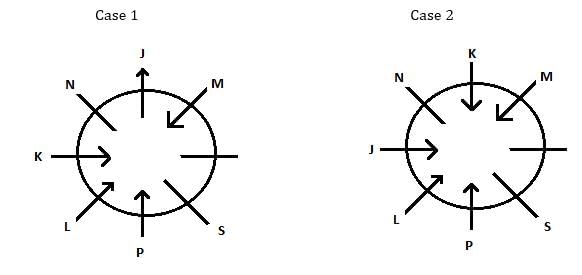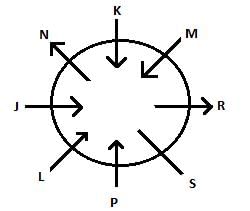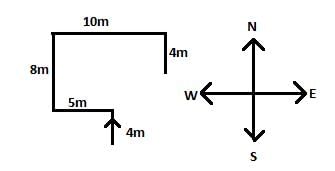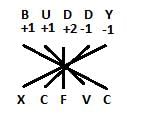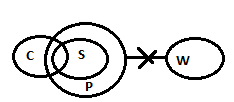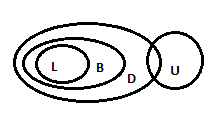NIACL Mock Test - 10 - Insurance MCQ
30 Questions MCQ Test NIACL (New India Insurance) Mock Test Series 2025 - NIACL Mock Test - 10
Study the following information carefully and answer the question given below-
Nine persons viz. J, L, M, R, T, P, Q, S and O are sitting in a straight line. Some are facing north and some are facing south (but not necessarily in the same order). Three persons sit between L and P. O sits second to the left of P and is at one of the end. Q is to the immediate left of L. R sits at the middle of the row and faces north. R is not a neighbor of Q. S sits to the immediate left of P. M faces south. M sits third to the right of J. Persons sitting at the end of the row faces same direction. T faces north. Immediate neighbors of L face same direction. M does not sit at any end. Immediate neighbors of P face opposite direction. The number of persons facing north is more than the number of persons facing south.
Q. Who among the following sits to the immediate right of Q?
Study the following information carefully and answer the question given below-
Nine persons viz. J, L, M, R, T, P, Q, S and O are sitting in a straight line. Some are facing north and some are facing south (but not necessarily in the same order). Three persons sit between L and P. O sits second to the left of P and is at one of the end. Q is to the immediate left of L. R sits at the middle of the row and faces north. R is not a neighbor of Q. S sits to the immediate left of P. M faces south. M sits third to the right of J. Persons sitting at the end of the row faces same direction. T faces north. Immediate neighbors of L face same direction. M does not sit at any end. Immediate neighbors of P face opposite direction. The number of persons facing north is more than the number of persons facing south.
Q. How many person sits between T and J?
Study the following information carefully and answer the question given below-
Nine persons viz. J, L, M, R, T, P, Q, S and O are sitting in a straight line. Some are facing north and some are facing south (but not necessarily in the same order). Three persons sit between L and P. O sits second to the left of P and is at one of the end. Q is to the immediate left of L. R sits at the middle of the row and faces north. R is not a neighbor of Q. S sits to the immediate left of P. M faces south. M sits third to the right of J. Persons sitting at the end of the row faces same direction. T faces north. Immediate neighbors of L face same direction. M does not sit at any end. Immediate neighbors of P face opposite direction. The number of persons facing north is more than the number of persons facing south.
Q. Who among the following sits to the immediate left of J?
Study the following information carefully and answer the question given below-
Nine persons viz. J, L, M, R, T, P, Q, S and O are sitting in a straight line. Some are facing north and some are facing south (but not necessarily in the same order). Three persons sit between L and P. O sits second to the left of P and is at one of the end. Q is to the immediate left of L. R sits at the middle of the row and faces north. R is not a neighbor of Q. S sits to the immediate left of P. M faces south. M sits third to the right of J. Persons sitting at the end of the row faces same direction. T faces north. Immediate neighbors of L face same direction. M does not sit at any end. Immediate neighbors of P face opposite direction. The number of persons facing north is more than the number of persons facing south.
Q. Four of the following five are alike in a certain way and hence form a group, which among the following do not belong to that group?
Study the following information carefully and answer the question given below-
Nine persons viz. J, L, M, R, T, P, Q, S and O are sitting in a straight line. Some are facing north and some are facing south (but not necessarily in the same order). Three persons sit between L and P. O sits second to the left of P and is at one of the end. Q is to the immediate left of L. R sits at the middle of the row and faces north. R is not a neighbor of Q. S sits to the immediate left of P. M faces south. M sits third to the right of J. Persons sitting at the end of the row faces same direction. T faces north. Immediate neighbors of L face same direction. M does not sit at any end. Immediate neighbors of P face opposite direction. The number of persons facing north is more than the number of persons facing south.
Q. How many persons face north?
Study the following sequence and answer the given questions.

Q. Which of the following element is 9th to the left of the one which is 23rd from the left end of the given arrangement?
Study the following sequence and answer the given questions.

Q. How many such digits are there in the given series each of which is immediately preceded by a symbol but not immediately followed by an alphabet?
Study the following sequence and answer the given questions.

Q. How many such symbols are there in the given series which are immediately preceded by an alphabet but not immediately followed by a number?
Study the following sequence and answer the given questions.

Q. How many such elements are there in the given series which are immediately preceded by a number and followed by a vowel?
Study the following sequence and answer the given questions.

Q. What should come in place of question mark (?) in the following series based on the above arrangement?

Following questions are based on the five words given below, Study the following words and answer the following questions. HIT O
AT DON FUN TOP
(The new words formed after performing the mentioned operations may not necessarily be a meaningful English word.)
Q. If the given words are arranged in the order as they appear in a dictionary from right to left, which of the following will be second from the left end?
Following questions are based on the five words given below, Study the following words and answer the following questions.
HIT OAT DON FUN TOP
(The new words formed after performing the mentioned operations may not necessarily be a meaningful English word.)
Q. How many letters are there in the English alphabetical series between the second letter of the word which is third from the right end and the second letter of the word which is last from the right end?
Following questions are based on the five words given below, Study the following words and answer the following questions.
HIT OAT DON FUN TOP
(The new words formed after performing the mentioned operations may not necessarily be a meaningful English word.)
Q. If in each of the given words, the second alphabet is replaced by its following alphabet and third alphabet is replaced by its preceding alphabet as per the English alphabetical order, then how many words thus formed will be without any vowels?
Following questions are based on the five words given below, Study the following words and answer the following questions.
HIT OAT DON FUN TOP
(The new words formed after performing the mentioned operations may not necessarily be a meaningful English word.)
Q. If the position of the last letter and the first letter of each word is interchanged, than how many meaningful English words will be formed in the new arrangement?
Following questions are based on the five words given below, Study the following words and answer the following questions.
HIT OAT DON FUN TOP
(The new words formed after performing the mentioned operations may not necessarily be a meaningful English word.)
Q. If in each of the given words, every consonant is changed to its previous letter and every vowel is changed to its next letter according to the English alphabetical series, than in how many words, thus formed, at least one vowel will appear?
Study the information and answer the following questions:
Eight persons J, K, L, M, N, P, S and R are sitting around a circular table (not necessarily in the same order). Some are facing inside and some are facing outside.
N sits third to the left of P, who faces inside. Two persons sit between M and P. L faces M. S sits third to the right of J. K, who faces inside is not a neighbor of S. R faces outside and is not a neighbor of J. N do not sit adjacent to S and faces opposite direction of J. The one who sits opposite to S does not face inside.
Q. Who among the following sits to the immediate left of S?
Study the information and answer the following questions:
Eight persons J, K, L, M, N, P, S and R are sitting around a circular table (not necessarily in the same order). Some are facing inside and some are facing outside.
N sits third to the left of P, who faces inside. Two persons sit between M and P. L faces M. S sits third to the right of J. K, who faces inside is not a neighbor of S. R faces outside and is not a neighbor of J. N do not sit adjacent to S and faces opposite direction of J. The one who sits opposite to S does not face inside.
Q. Who among the following sits exactly between M and L?
Study the information and answer the following questions:
Eight persons J, K, L, M, N, P, S and R are sitting around a circular table (not necessarily in the same order). Some are facing inside and some are facing outside.
N sits third to the left of P, who faces inside. Two persons sit between M and P. L faces M. S sits third to the right of J. K, who faces inside is not a neighbor of S. R faces outside and is not a neighbor of J. N do not sit adjacent to S and faces opposite direction of J. The one who sits opposite to S does not face inside.
Q. Who sits third to the left of K?
Study the information and answer the following questions:
Eight persons J, K, L, M, N, P, S and R are sitting around a circular table (not necessarily in the same order). Some are facing inside and some are facing outside.
N sits third to the left of P, who faces inside. Two persons sit between M and P. L faces M. S sits third to the right of J. K, who faces inside is not a neighbor of S. R faces outside and is not a neighbor of J. N do not sit adjacent to S and faces opposite direction of J. The one who sits opposite to S does not face inside.
Q. What is the position of M with respect to J?
Study the information and answer the following questions:
Eight persons J, K, L, M, N, P, S and R are sitting around a circular table (not necessarily in the same order). Some are facing inside and some are facing outside.
N sits third to the left of P, who faces inside. Two persons sit between M and P. L faces M. S sits third to the right of J. K, who faces inside is not a neighbor of S. R faces outside and is not a neighbor of J. N do not sit adjacent to S and faces opposite direction of J. The one who sits opposite to S does not face inside.
Q. In a certain way, N is related to K and L is related to J. Who is related to P in the same way ?
If “COAL” is coded as “458@”, “WOOD” is coded as “$557”, then “WOALD” will be coded as?
How many pairs of letters are there in the word “PREPARED” which have as many letters between them in the word as in alphabetical series?
Anil starts moving in the north direction. After walking for 4m he takes a left turn. He then takes a right turn after walking 5m. Again after walking for 8m he took right turn. He walks for 10m than takes a right turn and finally stops after walking 4m. In which direction is he at present with respect to his initial position?
In a certain code language ‘PLACE’ is coded as ‘DBCMQ’ and ‘TRUTH’ is coded as ‘GSWSU’. How ‘BUDDY’ will be coded in that language?
C is daughter-in-law of A, who is married to B. D is the only child of B. A is the grandmother of F. How is C related to D?
In each of the questions below are given some statements followed by two conclusions. You have to take the given statements to be true even if they seem to be at variance with commonly known facts. Read all the conclusions and then decide which of the given conclusions logically follows from the given statements, disregarding commonly known facts. Give answer
Statements:
Some C are S
All S are P
No P is W
Conclusions:
I. Some P are C
II. No S is W
In each of the questions below are given some statements followed by two conclusions. You have to take the given statements to be true even if they seem to be at variance with commonly known facts. Read all the conclusions and then decide which of the given conclusions logically follows from the given statements, disregarding commonly known facts. Give answer
Statements:
All F are J
No J is K
Some K are G
Conclusions:
I. Some G are not J
II. All F being K is a possibility
In each of the questions below are given some statements followed by two conclusions. You have to take the given statements to be true even if they seem to be at variance with commonly known facts. Read all the conclusions and then decide which of the given conclusions logically follows from the given statements, disregarding commonly known facts. Give answer
Statements:
Some R are T
Some D are not T
No H is D
Conclusions:
I. Some R are not D
II. No H is T
In each of the questions below are given some statements followed by two conclusions. You have to take the given statements to be true even if they seem to be at variance with commonly known facts. Read all the conclusions and then decide which of the given conclusions logically follows from the given statements, disregarding commonly known facts. Give answer
Statements:
All L are B
All B are D
Some D is U
Conclusions:
I. All U is B
II. Some U is not B
In each of the questions below are given some statements followed by two conclusions. You have to take the given statements to be true even if they seem to be at variance with commonly known facts. Read all the conclusions and then decide which of the given conclusions logically follows from the given statements, disregarding commonly known facts. Give answer
Statements:
No Z is R
Some R is A
Some A is T
Conclusions:
I. Some Z is not A
II. Some T is Z



